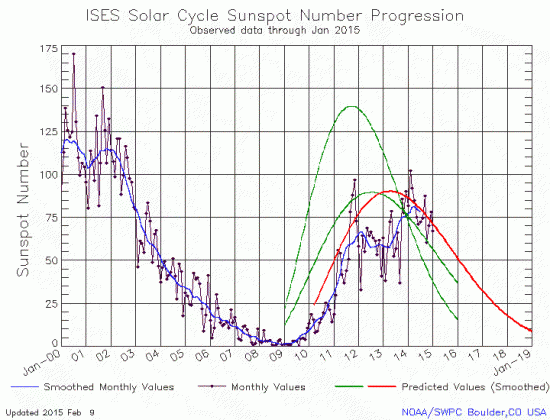Sunspot activity tracks prediction
On Monday NOAA posted its monthly update of the solar cycle, showing the sunspot activity for the Sun in January. As I do every month, I am posting it here below the fold, with annotations to give it context.
As I have noted previously, the ramp down from solar maximum continues to track the 2009 prediction of the solar scientist community (indicated by the red curve) quite closely. As NOAA also notes,
While awaiting final confirmation, all evidence points to the most recent solar maximum having peaked at 82 in April, 2014. This was within the expected range for the peak, but occurred significantly later than predicted.
Since their graph doesn’t show the entire curves for their predictions, the above statement seems reasonable. However, looking at the graph with those curves inserted (see my annotated graph below the fold), it becomes clear that not only did the peak occur much later than predicted, the maximum’s overall activity was also generally less than predicted.

The graph above has been modified to show the predictions of the solar science community. The green curves show the community’s two original predictions from April 2007, with half the scientists predicting a very strong maximum and half predicting a weak one. The red curve is their revised May 2009 prediction.
The new website for NOAA’s Space Weather Prediction Center continues to evolve. They have now moved these updates to this page, where they have also created a tab/link, not yet filled with data, where they intend to repost the 2007 and 2009 predictions of the solar maximum as made by the solar science community. Right now, all it includes is this statement: “A link to the original Solar Cycle Prediction Panel forecasts will be provided here.”
For the present it appears that NOAA will continue to update the monthly graphs as they have been doing for the past half decade. I expect however for this to end sometime in the next two years, when they will revamp everything in conjunction with the science community’s new prediction of the next solar maximum. At that time I will either take their revamped graphs and accept them as is, or merge them with this older graph, so as to give my readers the best long term context.
On Christmas Eve 1968 three Americans became the first humans to visit another world. What they did to celebrate was unexpected and profound, and will be remembered throughout all human history. Genesis: the Story of Apollo 8, Robert Zimmerman's classic history of humanity's first journey to another world, tells that story, and it is now available as both an ebook and an audiobook, both with a foreword by Valerie Anders and a new introduction by Robert Zimmerman.
The ebook is available everywhere for $5.99 (before discount) at amazon, or direct from my ebook publisher, ebookit. If you buy it from ebookit you don't support the big tech companies and the author gets a bigger cut much sooner.
The audiobook is also available at all these vendors, and is also free with a 30-day trial membership to Audible.
"Not simply about one mission, [Genesis] is also the history of America's quest for the moon... Zimmerman has done a masterful job of tying disparate events together into a solid account of one of America's greatest human triumphs."--San Antonio Express-News


Readers: the rules for commenting!
No registration is required. I welcome all opinions, even those that strongly criticize my commentary.
However, name-calling and obscenities will not be tolerated. First time offenders who are new to the site will be warned. Second time offenders or first time offenders who have been here awhile will be suspended for a week. After that, I will ban you. Period.
Note also that first time commenters as well as any comment with more than one link will be placed in moderation for my approval. Be patient, I will get to it.